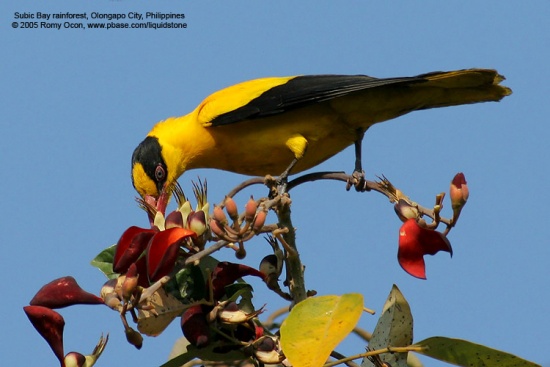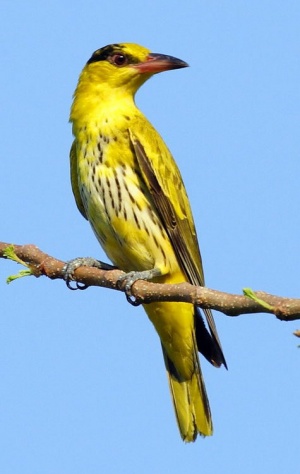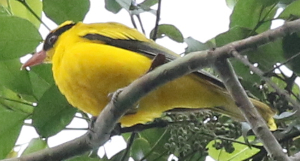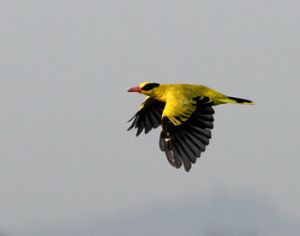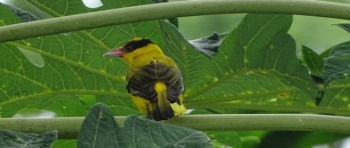- Oriolus chinensis
Identification
23–28 cm (9-11 in)
Male
- Bright golden-yellow plumage
- Black mask extending to nape
- Black and yellow wings and tail
- Pink bill
- Grey feet
- Red iris
Female: duller, greenish-yellow mantle.
Juvenile: whitish underparts, blackish streaks on breast, grey bill, lacks nape band.
Distribution
From India east over Indochina to the Philippines, Singapore, Indonesia and eastern China.
Taxonomy
The Slender-billed Oriole was considered to be conspecific but is now widely accepted as full species, including the subspecies invisus from southern Vietnam, formerly placed in Black-naped Oriole. Many Black-naped Oriole subspecies probably deserve full species status since there are 9 deeply (genetically) divergent lineages [3] (indicated against subspecies below).
Subspecies
Up to 20 subspecies are accepted [1]:
- O. c. diffusus: "Chinese Golden Oriole". Eastern Asia; winters to India, Malaysia and Indochina
- O. c. andamanensis: Andaman Islands
- O. c. macrourus: Nicobar Islands
- O. c. chinensis: "Philippine Golden Oriole". Philippine Islands
- O. c. suluensis: "Philippine Golden Oriole". Sulu Archipelago
- O. c. yamamurae: "Philippine Golden Oriole". Central and southern Philippines (Tablas, Panay, Romblon, Sibuyan, Masbate, and Samar south to Mindanao)
- O. c. melanisticus: "Celebes Sea Golden Oriole". Talaud Islands (Karakelong and Salebabu)
- O. c. sangirensis: "Celebes Sea Golden Oriole". Sangihe and Tabuken islands (off northern Sulawesi)
- O. c. formosus: "Celebes Sea Golden Oriole". Siau, Tahulandang, Ruang, Biaro and Mayu island (off Sulawesi)
- O. c. celebensis: "Sulawesi Golden Oriole". Sulawesi, Bangka, Talisei, Lembeh, Togian Islands, Muna, Butung
- O. c. frontalis: "Sula Golden Oriole". Banggai and Sula islands (off Sulawesi)
- O. c. boneratensis: "Flores Sea Golden Oriole". Tanahjampea, Bonerate, Lalaotoa, Madu and Kayuadi isla
- O. c. broderipi: "Tenggara Golden Oriole". Lesser Sundas (Lombok, Sumba, Sumbawa, Flores, Bisar, Alor)
- O. c. richmondi: "Sunda Golden Oriole". Siberut and Pagi islands (off Sumatra)
- O. c. maculatus: "Sunda Golden Oriole". Sumatra, Java, Borneo, Bali, Belitung and Nias islands
- O. c. mundus: "Sunda Golden Oriole". Simeulue Island (off Sumatra)
- O. c. sipora: "Sunda Golden Oriole". Sipura Island (off Sumatra)
- O. c. insularis: "Sunda Golden Oriole". Kangean Islands (Java Sea)
Habitat
Coastal woodlands and mangroves, farmland, parks and gardens, to 1600m.
Behaviour
Diet
Omnivorous, figs form a large part of their diet, along with fruit and berries. They also eat large insects, small animals and nestlings.
Breeding
A cup-shaped nest is made from bark, small twigs, grass and roots. The clutch consists of two to three bluish-white eggs with brown spots which are incubated for about 14 days.
References
- Clements, J. F., T. S. Schulenberg, M. J. Iliff, D. Roberson, T. A. Fredericks, B. L. Sullivan, and C. L. Wood. 2017. The eBird/Clements checklist of birds of the world: v2017, with updates to August 2017. Downloaded from http://www.birds.cornell.edu/clementschecklist/download/
- Andamanbirdwatching
- Eaton, J.A.. van Balen, B. Brickle, N.W., B Rheindk F.E. (2021). Birds of the Indonesian Archipelago, Greater Sundas and Wallacea. Lynx Edicions. Barcelona. Second Edition
Recommended Citation
- BirdForum Opus contributors. (2025) Black-naped Oriole. In: BirdForum, the forum for wild birds and birding. Retrieved 27 April 2025 from https://www.birdforum.net/opus/Black-naped_Oriole
External Links
GSearch checked for 2020 platform.1




